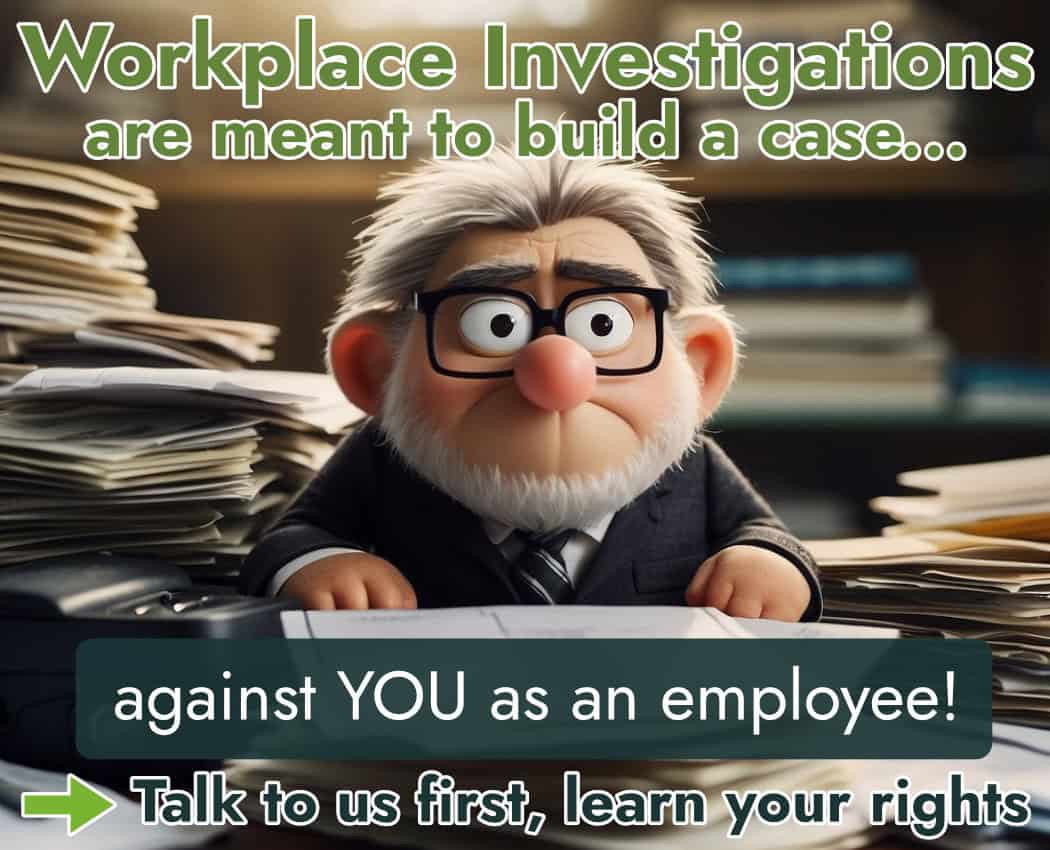
Harassment & Bullying Lawyers for Calgary Employees
Bullying and harassment in the workplace are recurrent patterns of unpleasant behavior directed against a specific individual or group. Bullying can also happen in isolated, single events. The pattern of conduct is generally intended to intimidate, offend, humiliate, or intimidate.
It can include physical abuse or threat of abuse but it usually causes psychological rather than physical harm. Workplace harassment can involve sexual harassment and discrimination.
The most serious kinds of bullying and abuse are often small in comparison to direct forms. Face-to-face encounters, verbal and non-verbal communication, and written communication (including email, texts, social media platforms) all constitute harassment.
Bullying and harassing behaviours can be exhibited by anyone – managers, supervisors, co-workers, subordinates, or clients. In other words, if someone is part of your organization or interacts with people in it regularly, they could be a bully.
BILL 30: HEALTH STATUTES AMENDMENT ACT
Bill 30 defines harassment as being inappropriate conduct, comment, display, action, or gesture by a person that constitutes a threat to the health or safety of the worker and that is either based on:
- certain enumerated grounds (such as colour, gender, or place of origin); or which
- adversely affects the worker’s psychological or physical well-being.
Further, in respect of (ii), the amendment adds a couple of other preconditions:
- The harasser must know or ought reasonably to know that their actions would cause a worker to be humiliated or intimidated; and
- The harasser’s actions must either be repeated or a single serious occurrence that has a lasting harmful effect on the worker.
Employer Responsibility
The amendment further provides that every employer must establish and administer a workplace harassment policy and that every employer has a responsibility to investigate workplace harassment complaints. It also includes a dispute resolution mechanism in the event the employee is unsatisfied with their employer’s process. The resolution mechanism includes filing a complaint with an officer as well as mediation.
If mediation is unsuccessful, and the officer finds an employee’s complaint to be substantiated, the officer also has the power to “order the employer to undertake corrective action”.
What if the employer doesn’t comply with Bill 30?
The question then becomes, what happens if an employer doesn’t comply with the amendment or an order of an officer? The answer is that the current enforcement provisions of the OH&S Act would apply: an employer could be ordered to pay an administrative penalty or be found guilty of an offence and fined accordingly.
In other words, Bill 30 provides employees with a dispute resolution mechanism in the event that they experience harassment in the workplace while existing provisions in the OH&S Act will help to ensure employers comply with it.
With that said, neither Bill 30 nor the current OH&S Act, provide the victim of harassment with compensation nor deal with a situation where the victim is unable, due to the harassment, to stay in the workplace. It should therefore be remembered that Bill 30 if passed, is not a complete code to an employee’s rights. Instead, it merely provides employees with an additional remedy to those already in existence below.
SUING FOR HARASSMENT IN ALBERTA. IS IT POSSIBLE?
An employee who has been harassed or bullied in the workplace often wants to bring a lawsuit against either their employer or a colleague for the tort of “harassment”. Unfortunately, whether harassment constitutes a valid tort is an open question in Alberta2. Because the issue is unsettled, we do not know what an employee would have to prove to be successful. With that said, as discussed below, employees still have several options available to them should they become the subject of this type of conduct.
THE MOST COMMON CLAIM: CONSTRUCTIVE DISMISSAL
How constructive dismissals works
An employer owes a duty to its employees to
- treat them fairly, with civility, decency, and with respect and to
- ensure that the work environment does not become hostile, embarrassing, or forbidding.
The first typically applies in respect of how a supervisor or manager treats their direct reports, while the second applies in respect of how colleagues treat each other.
An employer who fails to satisfy these duties, such that competent performance of that employee’s work becomes intolerable, exposes itself to the following possibility:
an employee quitting and arguing that they have been “constructively dismissed”. This is likely the most common claim an employee will make upon being harassed in the workplace, particularly because the conduct that could amount to making the workplace intolerable isn’t closed nor defined.
The following are case examples of successful constructive dismissal claims based on a breach of the above two duties:
- Lloyd v Imperial Parking3, where the plaintiff’s supervisor continually shouted, swore, and threatened to terminate him;
- Stamos v Annuity Research & Marketing Service Ltd.4, where a colleague, among other things, made unjustified complaints about the plaintiff to their employer; kicked in the plaintiff’s office door during a disagreement; and made lude comments about women for all to hear; and
- Sweeting v. Mok5, where an employer had an outburst toward the plaintiff, in front of the plaintiff’s subordinate, which involved yelling, profanity, and insults.
Employee entitlement upon a constructive dismissal
If an employee’s constructive dismissal claim is successful, the question then becomes: what is that employee entitled to? The answer is that employment agreements include an implied term requiring employers to give employees common law reasonable notice of termination, regardless of whether the termination occurs expressly or constructively.6
Courts determine an employee’s common law reasonable notice period based on various factors such as age, length of service, and character of employment—with the rough high end being around 24 months for long service employees.
Of course, when an employer constructively dismisses an employee by making or allowing the work environment to become intolerable, the employer won’t be in a position to provide the employee with reasonable notice.7
Instead, the employer will be seen to have breached this implied term, such that they are liable for the damage that results. This damage is typically everything the employee would have earned had appropriate notice been given, otherwise known as “pay in lieu of reasonable notice” or “severance”.
For example, if an employee, taking into account all of their factors, would have been entitled to 6 months’ notice, then their claim for constructive dismissal would equal to what they would have earned over this period.
OTHER POSSIBLE CIVIL CLAIMS RELATED TO HARASSMENT IN THE WORKPLACE
In addition to suing for constructive dismissal, employees have several other civil remedies available to them, depending on the facts of their case. Possible actions include but are not limited to damages for the manner of dismissal, intentional infliction of mental suffering, and battery. Each is described more fully below.tiff could collect from either of them.
MANNER OF DISMISSAL
When an employer terminates an employee in the normal course the employee will often experience some form of distress and hurt feelings. This is not compensable and won’t result in increased damages. With that said, both employees and employers share a mutual expectation that employers will act honestly, reasonably, and in good faith in the manner of dismissal. If the employer fails to do so, and the employee suffers foreseeable damages because of it, then the employer will be responsible for that damage.
For example, in Piresferreira v Ayotte (Ayotte), the plaintiff, Marta Piresferreira, was an employee at Bell Mobility Inc. (Bell) in the position of account manager. Her direct superior, Richard Ayotte (Mr. Ayotte), was critical, demanding, loud, and aggressive, while others described the plaintiff as nervous and sensitive.
Despite their different personalities, the plaintiff received excellent performance reviews until a less than stellar review in 2004. As a result of this review, Bell’s general manager instructed Ayotte to monitor the plaintiff’s performance during the first quarter of 2005 and to consider issuing her a performance improvement plan (a PIP). Thereafter, on May 4, 2005, Mr. Ayotte received a sample PIP from HR.
On May 12, 2005, before Mr. Ayotte had given the plaintiff the PIP, Mr. Ayotte and the plaintiff had a heated discussion that resulted in Mr. Ayotte pushing the plaintiff. In response, the plaintiff went home. After the incident, Mr. Ayotte hastily prepared the PIP and sent it to HR that afternoon without mentioning the confrontation earlier that day.
On May 19, 2005, the plaintiff returned to work, and Mr. Ayotte presented her with the PIP which required that she report to him daily on her activities and attend bi-weekly meetings with him. Upon receiving the PIP, the plaintiff refused to sign it and again went home.
The next day, on May 20, 2005, the plaintiff formally complained to HR about Mr. Ayotte. On May 24, 2005, HR sent the plaintiff two communications. The first stated that HR would respond to the plaintiff’s complaint by end of day and that they had scheduled a meeting between the Plaintiff, Mr. Ayotte, and HR the following morning to review the PIP. The plaintiff responded to HR by stating that she was on sick leave, which was supported by her family doctor, and indicated that she would therefore be unable to attend the meeting. The second communication from HR stated that:
- the plaintiff declined to attend a meeting to allow Mr. Ayotte to offer a formal apology to her (even though the first communication said nothing about an apology); and that
- Mr. Ayotte would receive a written disciplinary warning and would have to attend two courses on effective communication and resolving conflict.
After receiving the letters from HR, the plaintiff did not attend work again and in August 2005, launched a lawsuit against both Mr. Ayotte and Bell. In respect of Bell, Ms. Ayotte claimed, among other things, that (i) it constructively dismissed her; and that (ii) it breached the above duty: to treat her reasonably, and in good faith in the manner of dismissal.
The plaintiff was successful on both causes of action. In respect of the second, the court found ample evidence to support a bad faith dismissal based not only on the push but also the fact that:
- Ayotte deliberately timed the delivery of the PIP in an attempt to ward off any potential of the plaintiff complaining to HR;
- HR emailed the plaintiff on May 24, 2005, advising that a meeting had been scheduled to review the PIP but then later claimed that she declined to attend a meeting that had been scheduled to allow Mr. Ayotte to apologize, and that
- Bell failed to take adequate action to ensure the plaintiff could feel safe in returning to work.
Since the above actions resulted in psychological damage to the plaintiff (like anxiety and depression), the Court awarded $45,000 over and above what the plaintiff was entitled to for pay in lieu of notice for the constructive dismissal.
INTENTIONAL INFLICTION OF MENTAL SUFFERING
The tort of intentional infliction of mental suffering has three elements:
- the defendant must have engaged in outrageous or extreme conduct;
- there must be proof of actual intent to cause harm of the kind suffered; and
- the plaintiff must show that they have suffered a recognizable psychiatric illness or physical harm.
Historically, this tort was most often proved in cases of a single shocking event. For example, Wilkinson v Downton (Wilkinson)8is the textbook example. In this case, the defendant played a practical joke on the plaintiff which involved telling the plaintiff a lie: that her husband had been in an accident, was injured, and that he was lying in a tavern with both legs broken. The result of the comments was that the plaintiff suffered prolonged mental and physical suffering.
However, since Wilkinson, Courts have expanded the tort to include patterns of behaviour, including in the employment law context. For example, in Clark v Canada9, the plaintiff, a female RCMP officer, successfully proved the above three elements after she was subjected to repeated harassment over a period of years by male constables (which her superiors failed to correct) causing her severe stress and depression.
Like damages for the manner of dismissal, employees often claim for intentional infliction of mental suffering alongside their constructive dismissal action.
BATTERY
In addition to the manner of dismissal and the tort of intentional infliction of mental suffering, employees could have a claim for battery if the harassment or bullying becomes physical. Battery is defined as a direct intentional physical interference of another that is either harmful or offensive to a reasonable person.
Examples of battery include cutting a person’s hair, spitting on a person, punching, slapping, pushing, as well as sexual contact (unless there is some justification such as consent). In contrast, intentional physical interference that is not harmful or offensive will not be a battery. For example, tapping someone on the shoulder to ask a question ordinarily wouldn’t suffice. With that said, whether a certain physical interference constitutes battery always depends on the circumstances and must satisfy the test outlined above.
While battery is rare in the workplace (as it should be), it does happen. For example, in Ayotte, as outlined above, the plaintiff’s manager pushed her during a heated discussion. Thereafter, she claimed not only for constructive dismissal and damages for the manner in dismissal but also battery. In respect of the latter, the Court awarded her $15,000 notwithstanding that she suffered “no physical injury, psychological harm or other ill effects from the push itself”. Further, the Court found Mr. Ayotte and Bell jointly and severally liable for these damages, meaning that the plaintiff could collect from either of them.
HARASSMENT UNDER THE ALBERTA HUMAN RIGHTS ACT
Elements of the claim
In addition to constructive dismissal and the other civil claims that often go along with it, some employees may have a claim for bullying or harassment pursuant to Alberta Human Rights Act, RSA 2000 c A-25.5 (the AHRA). Specifically, section 7 of the AHRAstates that no employer shall discriminate against any person with regard to employment or any term or condition of employment because of race, religious beliefs, colour, gender, physical or mental disability, source of income, age, ancestry, place of origin, marital status, family status, or sexual orientation (Protected Grounds).
Courts have found employers to breach this section in cases of harassment, so long as that harassment was based on Protected Grounds. Specifically, harassment in the human rights context is defined as follows: “unwelcome conduct related to prohibited grounds of discrimination that detrimentally affects the work environment or leads to adverse job-related consequences…”10
For example, in Janzen v Platy Enterprises Ltd.11two restaurant employees were subjected to both unwanted sexual remarks and sexual contact from one of the other employees, Tommy Grammas, the restaurant cook. Despite notifying their employer of his conduct, the employer was unsympathetic and did nothing about it. Thereafter, one of the employees quit while the employer terminated the other. Both subsequently brought a human rights complaint and were ultimately successful. Importantly, the Court concluded that (i) the conduct amounted to harassment based on the protected ground of gender notwithstanding that not every female worker was subjected to it; and that (ii) the employer was responsible for the actions of Tommy Grammas, its employee because he committed them during the “course of his employment”.
Damages if successful
If an employee’s human rights claim is successful, then they will be entitled to remedies for the breach. This can include:
- lost wages—often for the period of unemployment;
- damages for loss of dignity and self-respect, which are essentially damages for the breach and are not to compensate the employee for any monetary loss; and
- reinstatement. Though, this may be unworkable depending on the circumstances.
In other words, unlike damages for constructive dismissal, these remedies are intended to “make the employee whole”, creating a significant amount of liability for the employer. For example, in Cowling v Alberta12, an age discrimination case, the tribunal awarded, among other things, lost wages for a period of 5 years, the amount of time the employee was unemployed due to the discriminatory conduct, less than 30% for certain contingencies.
WHAT SHOULD YOU DO WHEN YOU’VE EXPERIENCED BULLYING OR HARASSMENT IN THE WORKPLACE?
If you are the subject of bullying or harassment (sexual or otherwise) you may be entitled to multiple remedies depending on your circumstances.
Booking a consultation with one of our lawyers will help you determine the options that are available to you as well as which option best suits your needs.
Book A Consultation
At Taylor Janis LLP, we have the skills, knowledge, and expertise to handle all of your employment & labour law needs.
1 RSA 2000 c O-2.
2 2015 ABQB 320 at para 20.
3 (1996) 192 AR 190 (QB).
4 [2002] OJ No 1865 (ONSC).
5 2015 ONSC 2154.
6 Note: Employers can replace this implied term with an express provision reducing or even eliminating an employee’s common law notice, though such provision must satisfy certain requirements to be enforceable, including limiting language that’s clear and unambiguous.
7 Note: Notice would be the equivalent of the following: On “x” date, “x” months from now, we will be making your work environment intolerable. This, of course, is not practical.
8 [1897] EWHC 1.
9 (1994), 20 CCLT (2d) 241 (FCTD).
10 Malko-Monterrosa v Conseil Scolaire Centre-Nord 2014 AHRC 5.
11 [1989] 1 SCR 1252.
12 2012 AHRC 4.

Our Calgary intake staff are standing by to help you. Call 403-474-0411 [toll free 1 (844) 521-1715] or contact us online for general inquiries.
We also have a dedicated intake form to help you get the ball rolling. Our intake team will review your specific case and advise you on the next steps to take as well as what to expect moving forward.
Our Calgary office is open 8:30 a.m.—4:30 p.m., Mon—Fri.


Illya Shcherba
WORKPLACE LAWYER
Illya is genuinely committed to a client-centred approach in his practice of law. This commitment comes from Illya’s ability to be empathetic towards others. Illya understands that providing good quality, strategic advice comes from listening to others and understanding their needs and wants.
PRIVACY NOTICE: Any information you provide to our office — whether your personal information or employment/employer details — will be treated as strictly confidential and will not be disclosed to your employer or to any other third party. So, please be reassured that you can talk openly to our capable Intake Paralegals worry free. Fill out an Online Inquiry or call us now, your information will be in safe and helping hands.
The Legal Review Process by Taylor Janis Workplace Law
- Taylor Janis strives for high-quality, legally verified content.
- Content is meticulously researched and reviewed by our legal writers/proofers.
- Details are sourced from trusted legal sources like the Employment Standards Code.
- Each article is edited for accuracy, clarity, and relevance.
- If you find any incorrect information or discrepancies in legal facts, we kindly ask that you contact us with a correction to ensure accuracy.


